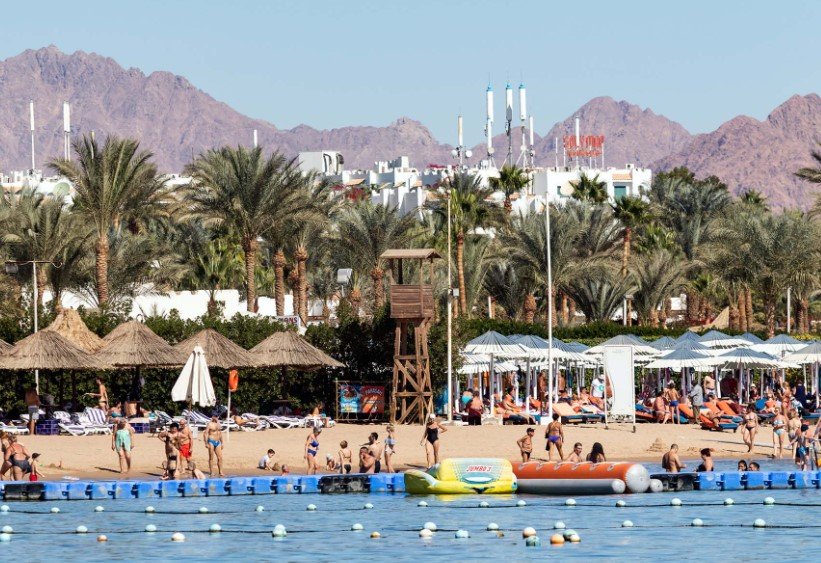A once-public coastline is now lined with private gates, luxury resorts, and prices that push ordinary Egyptians out of the picture.
A day at the beach used to mean just that — packing food from home, catching a microbus with friends, and dipping your feet into the warm Mediterranean. But not anymore. For many Egyptians, especially those who don’t live in gated compounds or have thousands to drop on a single night’s stay, their country’s North Coast has quietly slipped out of reach.
Welcome to the North Coast, Where Entry Comes With a Price Tag
Egypt’s North Coast — or Sahel, as locals call it — is stunning. No one’s denying that.
Stretching from Alexandria to Marsa Matrouh, it boasts some of the cleanest sand and clearest waters anywhere in the Mediterranean. But there’s a catch. Access is increasingly limited to those who can pay for it — and pay a lot.
Over the past two decades, the coastline has transformed from scattered public beaches into a patchwork of exclusive resorts and mega-developments. Most have private security, require residency or advance reservations, and offer little to no access for people who aren’t part of Egypt’s economic elite.
Ironic, isn’t it? A country with more than 1,000 kilometers of coastline — and millions can’t touch a toe in the sea.

The Economics of Exclusion
Let’s talk numbers for a moment.
A basic chalet in a mid-tier North Coast resort can cost upwards of EGP 25,000 ($520) per week in peak summer. That’s more than half the average monthly salary in Egypt, which the Central Agency for Public Mobilization and Statistics pegs around EGP 10,000 ($210).
Now add food, transport, entry fees (yes, even inside gated communities), and you’re looking at the kind of bill that makes a weekend at the beach feel like a five-star international vacation.
For comparison:
-
Entry to a public beach in Alexandria? EGP 25–50
-
Entry to a North Coast compound’s private beach (if allowed)? EGP 300–800, sometimes just for the day.
In the words of a Cairo-based civil engineer: “The beach isn’t for us anymore. It’s for the people with property, not passports.”
Beaches Divided by Gates and Class
You feel it the moment you hit the coastal highway. One compound after another, walls painted white, black-clad security checking names at every entrance. The North Coast isn’t a place you visit — it’s a place you’re invited to.
Even Egyptians with some means struggle to get in unless they own or rent inside one of these developments.
And for the majority? There are no sidewalks or access points between resorts. You might drive along the sea for miles and never see it.
One-sentence pause here.
Some resorts have even banned food delivery apps from entering the premises to maintain a certain “vibe.” The message is loud and clear: if you’re not spending big, you’re not welcome.
Social Media, Status, and the Pressure to Perform
The North Coast isn’t just about sun and sand anymore — it’s a social stage.
Instagram, TikTok, and Snapchat are flooded each summer with videos of pool parties, club nights, and brunches in Sahel’s most elite spots. Everything from what you wear to where you stay has become a subtle competition — or not so subtle, depending on who’s posting.
For many upper-middle-class Egyptians, there’s a strange kind of peer pressure to show up and show off. Some even go into debt for the privilege.
But here’s the thing: the luxury isn’t just curated — it’s manufactured.
Inside some gated communities, developers import sand from outside and use artificial lagoons to enhance the “beach feel” for residents whose villas don’t face the sea. Meanwhile, locals living just a few kilometers away can’t afford a simple swim.
Public Beaches Are Shrinking — Literally
Egypt’s Ministry of Tourism and Antiquities insists there are still public beaches along the North Coast. Technically, that’s true. But in practice, it’s complicated.
Here’s a quick comparison:
| Beach Type | Accessibility | Typical Cost (per day) | Amenities |
|---|---|---|---|
| Public (Alexandria) | Easy | EGP 25–50 | Basic |
| Resort-Private | Restricted | EGP 500–2,000+ | Premium |
| Semi-Public (with minimum spend) | Limited | EGP 300+ minimum | Variable |
Many of the remaining public beaches are overcrowded, poorly maintained, or poorly connected to transport.
One woman from Giza said she hadn’t taken her kids to the sea in four years: “It’s just not possible anymore. The buses are expensive. Then you pay to enter. Then you pay for chairs. Then food. Then umbrellas. It’s better to just stay home.”
The Government’s Role: Silent or Complicit?
There’s no official statement from the Egyptian government about the increasing privatization of coastal space, but its silence speaks volumes.
Real estate along the coast is booming, and some of Egypt’s largest developers — including Palm Hills, Hassan Allam, and SODIC — have multi-billion-pound investments tied to coastal projects. That kind of money talks.
A few MPs have raised questions about beach privatization, especially when public lands are leased for luxury developments. But meaningful change? Nowhere in sight.
Meanwhile, tourism ads continue to sell Egypt as a destination of sun and fun — just not for Egyptians without credit cards.
Whose Beach Is It, Really?
In a country where inflation has eroded purchasing power and bread lines stretch longer each year, the sea — vast, free, and natural — should be the one thing left untouched by inequality.
But even that’s gone now.
What used to be a public right has become a lifestyle product. Coastal air is now luxury. Swimming is seasonal privilege. And the country’s own citizens? Locked out of their own backyard.
The saddest part? Many Egyptians under 30 have never even seen their country’s northern shore.
